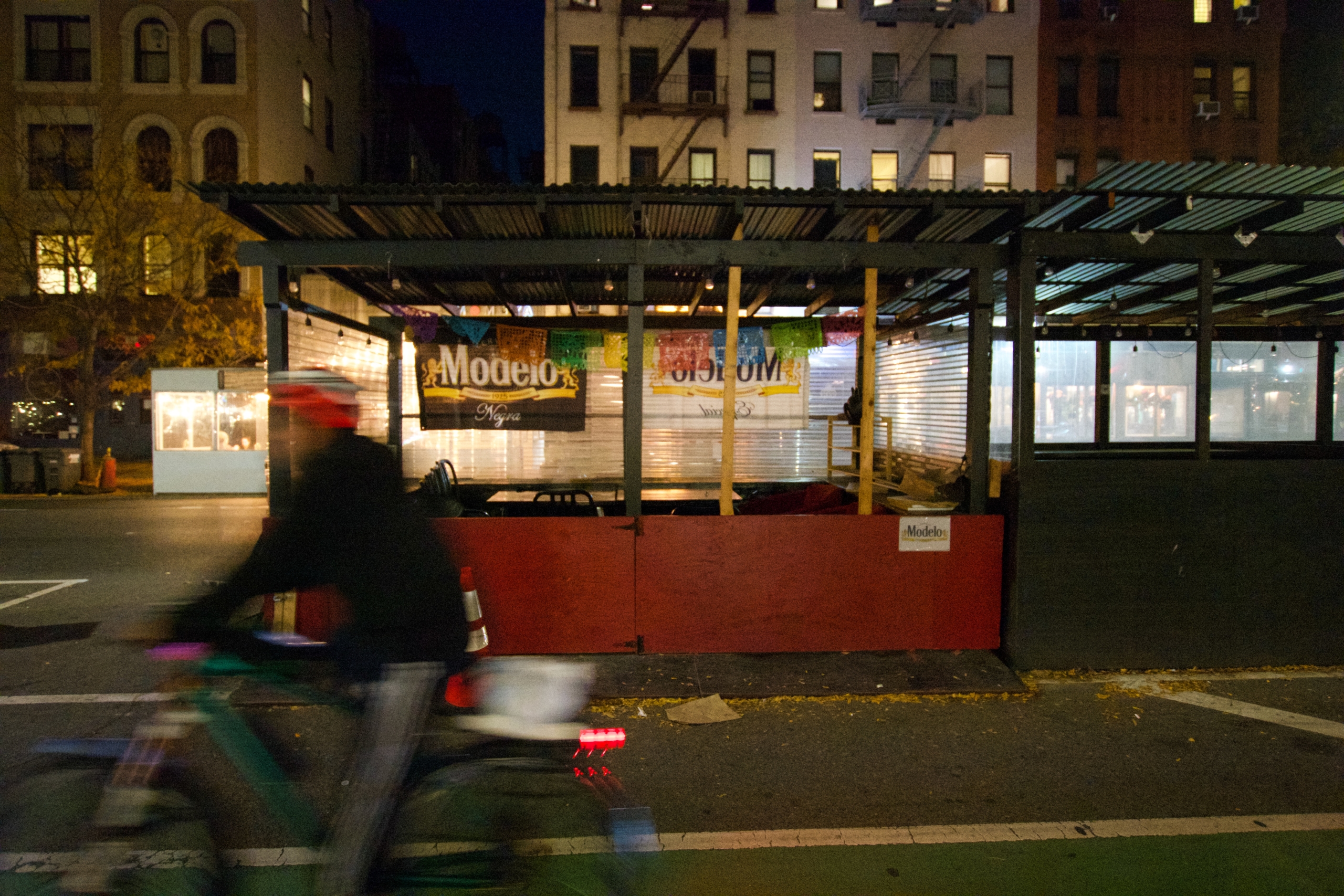
By Alex Maroño Porto
Around 2 p.m on a November day, when the temperature hovered in the mid-30s, Armando, 30, chatted with four other men near the Citibike station at W. 78th Street and Amsterdam Avenue. The men were all deliveristas, workers on bikes who relay meals from restaurants to apartments all over the city. Armando, a native of Hidalgo, Mexico, lives in Harlem but works most days on the Upper West Side, making 20 to 30 deliveries each day, for 12 hours a day, to make ends meet. Like the other deliveristas interviewed for this story, Armando is only identified by his first name because – like many who do this job in the city – he is undocumented. Armando has been working as a New York City delivery worker for the past seven years, first for a restaurant and then for DoorDash and Relay, two delivery apps.
As they wait to be notified of new orders placed with the apps, the men hang out on the street – or sit in shelters like the abandoned outdoor dining shed at Oaxaca Taquería at Amsterdam Avenue and W. 80th Street, which closed in November. There, they are shielded by the shed’s corrugated metal roof and translucent plastic walls, covered with two Modelo beer banners, as they watch their phones for new delivery alerts. “We pick it up and we carry it out,” said Armando, who was interviewed in Spanish. “Working all day is exhausting and also dangerous, but here [next to the CitiBike station] we rest.”
Armando lives on 168th Street in Harlem with his brother David, 29, a six-year DoorDash deliverista. But both prefer to work on the Upper West Side. The neighborhood is safer, they say, and the customers tip well. “The moment you go to the East Side or further down, you expose your life,” said David, who was also interviewed in Spanish. “There is much more traffic and you have more problems with cars.”
The brothers migrated to the United States as minors, leaving both parents behind, to escape Mexico’s precarious economy. “There’s no work in Hidalgo,” said Armando, who crossed the southern border when he was 17 and spent two years in Texas before coming to New York City. “My friends from Mexico were here,” he said. “I contacted them in Texas and ended up coming.”
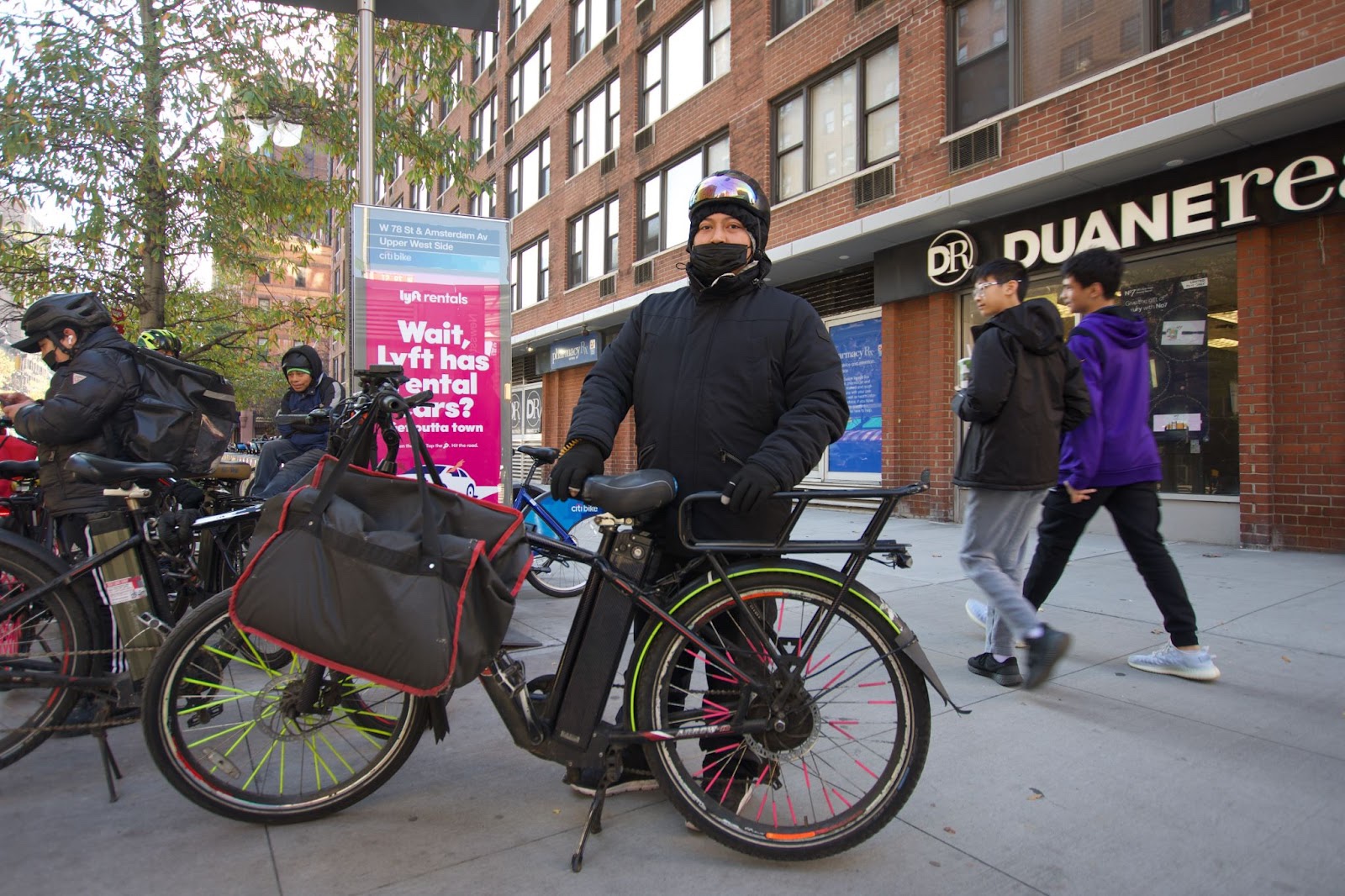
Armando and David are among the 65,000 New York deliveristas, a small army of workers, many from Mexico or other Latin American countries, who speed through city streets on electric bikes, sometimes alarming pedestrians while catering to New Yorkers’ takeout food culture. Their pathways are the city’s streets, sidewalks and nearly 600 miles of bike lanes, roughly the distance between Times Square and Dayton, OH. Their bikes cost about $2,000 and are paid for by the workers. Each deliverista pays another $40 or so for a helmet and insulated delivery bag.
Deliveristas working for the apps have been considered independent contractors, paid for each delivery they make rather than being on salary. Sick leave, health insurance and other benefits are generally not provided. During the pandemic they were considered essential workers, and more attention was paid to their working conditions – such as not having rest areas or restrooms to use between deliveries. Last year, the City Council approved a bill that promised deliveristas would be able to access restrooms in city restaurants, but some deliveristas say it hasn’t helped much. “Sometimes restaurants don’t let you use their restrooms,” said David. “They don’t let you in and make you wait outside.”
“It should be mandatory that we are allowed a space to use the bathroom,” said Juan, a 46-year old Puebla, Mexico, native who came to New York 14 years ago as an undocumented migrant.
In October, Mayor Eric Adams and Sen. Chuck Schumer announced that the city would convert public structures such as newsstands into “a place to rest and recharge,” where deliveristas can shelter between orders and charge their bicycles and cell phones. The political initiative is financed with a $1 million grant from the federal government, though it’s not clear how quickly the rest hubs will be available.
New York’s deliveristas also may start receiving a minimum hourly wage of $17.87 on January 1, according to The City, with an increase to $23.82 by April 1, 2025. According to a city study, New York’s deliveristas are currently paid by the number of deliveries they make, and their take home pay averages a little over $11 an hour, with tips. Details of the proposed new minimum wage will be debated December 16 at a virtual public hearing. The minimum wage is part of a 2021 New York City Council law that aims to strengthen the deliveristas’ labor rights, though some delivery workers are calling for an additional $5 an hour. And the proposed minimum wage faces potential legal challenges by the delivery apps, which already sued the city last year regarding a cap on restaurant fees.
Apps such as DoorDash currently set a base payment for each delivery, depending on the time needed and distance traveled to make the delivery. Deliveristas are notified in advance how much a customer is tipping, and that amount is passed on in full to them. Although some customers might leave no tip, Armando said he will still take a no-tip order so that he earns points to qualify as a Top Dasher at the end of the month. When an app accepts an order, it sends a notice to a deliverista in the vicinity of that order, but DoorDash gives priority to those with Top Dasher status. Grubhub has a similar rewards program called “Premier Driver.”
David, one of the brothers from Hidalgo, says that moving from the pay-per-delivery system to a minimum wage for deliveristas would give him a more reliable income and reduce the pressure to speed through city streets – which leads to pedestrian and driver complaints – in order to make more deliveries. “Now, if you don’t take a delivery, you’re not going to earn money,” he said. “Everyone would have a fixed salary,” said David. “Everyone has to pay rent, everyone has to eat and everyone has a family. We need money.”
David used to work in restaurants, first as a dishwasher and then as a cook, as well as making deliveries. When COVID hit, he said, he jumped on his bike full-time. “Jobs were shut down, there was only work in delivery.”
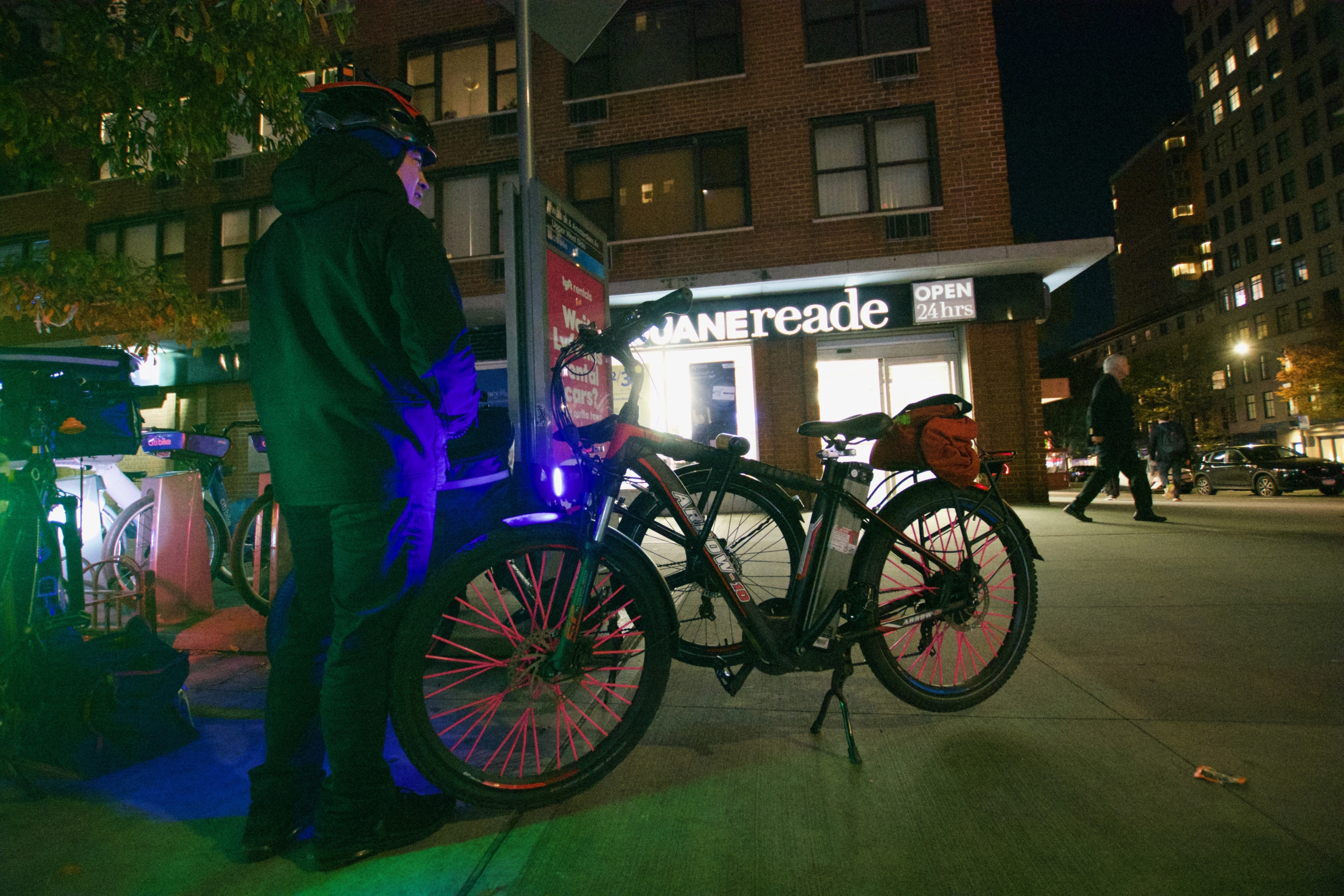
Armando says moving to a minimum hourly wage will also increase safety for the deliveristas, by reducing the pressure to speed up and run through red lights in order to make more money. “It will improve my life because we are not going to be in a hurry rushing to deliver an order,” he said.
Spending more than eight hours a day passing furiously honking cars and zigzagging on pedestrian walkways exposes deliveristas and others on the street to accidents. Alberto, 27, one of the deliveristas who shelters between orders at the dining shed outside Oaxaca Taquería, has suffered two work-related accidents since he came here from Mexico City in 2021.
Alberto had hoped to work in construction but instead started delivering food for Uber Eats and then Grubhub several months ago in order to save money for Occupational Safety and Health Administration (OSHA) training, which New York requires for construction jobs. “Of the apps, [I like] that I manage my own time, my schedule and that I can take the day off whenever I want, I have no one to pressure me,” Alberto said in an interview in Spanish. “You are your own master, your own boss, you know if you work or not.”
Despite the flexibility, Alberto said he works very long days, waking up around 5 a.m. in Brooklyn then biking for an hour to the Upper West Side, where he prefers making deliveries because the customers are friendly. “People here have treated me very well,” he said. “They help you, they are very kind.”
Traffic is also less menacing than in other parts of the city, said Alberto. As he was riding through Times Square one day, someone opened a car door in his path and he crashed into it. Though injured, he said he left quickly, unsure of his English skills and fearful of police because of his undocumented status. “I left with a heavy blow in my chest,” he said. Delivery apps generally don’t offer health insurance, and Alberto had to cover the expenses of a doctor’s appointment. He said he went to a private practitioner in Queens he knew through other deliveristas and ended up paying $50, including the cost of medicine. A few weeks ago, he was in another accident, falling on concrete after hitting a car that ran through a red light although, this time, his injuries —a knee scratch— didn’t require medical attention.
When he reaches the Upper West Side in the morning, Alberto usually starts the day with coffee before he makes his first delivery. From there, the workday often stretches more than 13 hours, until he’s finally back in Brooklyn around 10 p.m. “This is our meeting point,” he said, as he rested in a chair within the taqueria dining shed. “If there is nothing, we come here, sit down, and we talk.” All the deliveristas have a common goal, he said. “We don’t want to hurt anyone, we just came to work.”
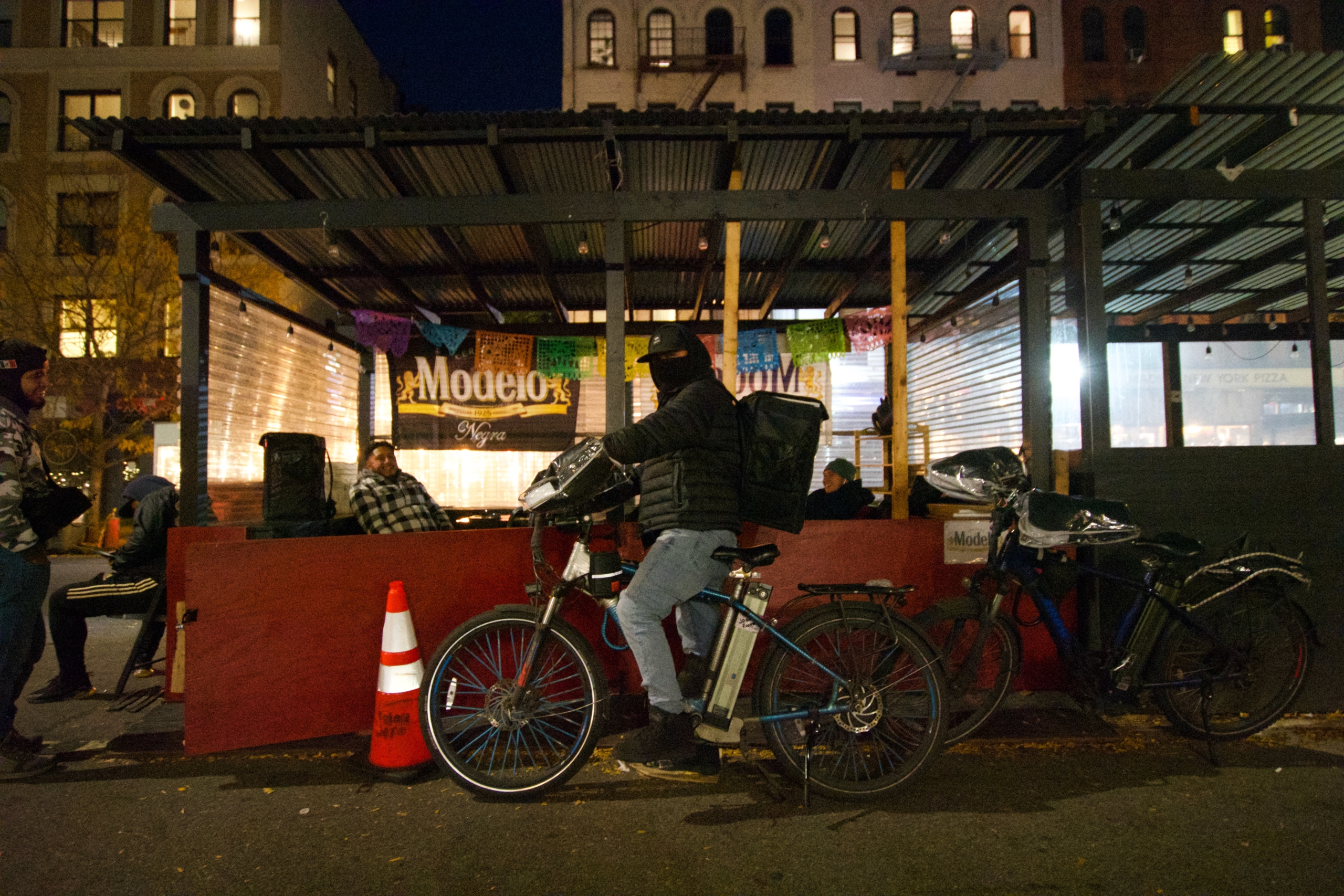
According to the organization Los Deliveristas Unidos, a collective of delivery workers, 16 New York City deliveristas were killed in 2020 and 2021, the majority of them in traffic accidents. Several more, like Be Tran, Christian Catalan and Zhiwen Yan were killed so far this year. “Forty-nine percent of survey respondents reported having been in an accident or crash while doing a delivery,” said a report published in September 2021 by Los Deliveristas and co-authored by The Worker Institute at Cornell University. According to the study, 75% of those injured had to pay for medical care out of their own pockets.
Although Alberto thinks the change to an hourly salary might decrease the overall number of accidents, he doesn’t support the initiative. He said he believes it will lead to heightened surveillance from the delivery platforms: “The app will put more pressure on you because now you’re receiving a paycheck, they will be monitoring you,” he said.
He also worries that apps will limit the number of hours each deliverista can work. “We are now working from 7:00 a.m. to 11:00 p.m, and we may be limited to working only eight hours,” he said. Reducing the number of hours they are allowed to work would have a negative impact on their income, despite the fixed salary, he said. “You’re earning per hour and it wouldn’t be very convenient for us.”
Switching to minimum wage will not resolve another issue that plagues the deliveristas: bike theft. Juan, the deliverista from Puebla, said he hears about bikes being stolen from deliveristas every day. “Some colleagues have called the police and have received little cooperation,” he said in an interview in Spanish.
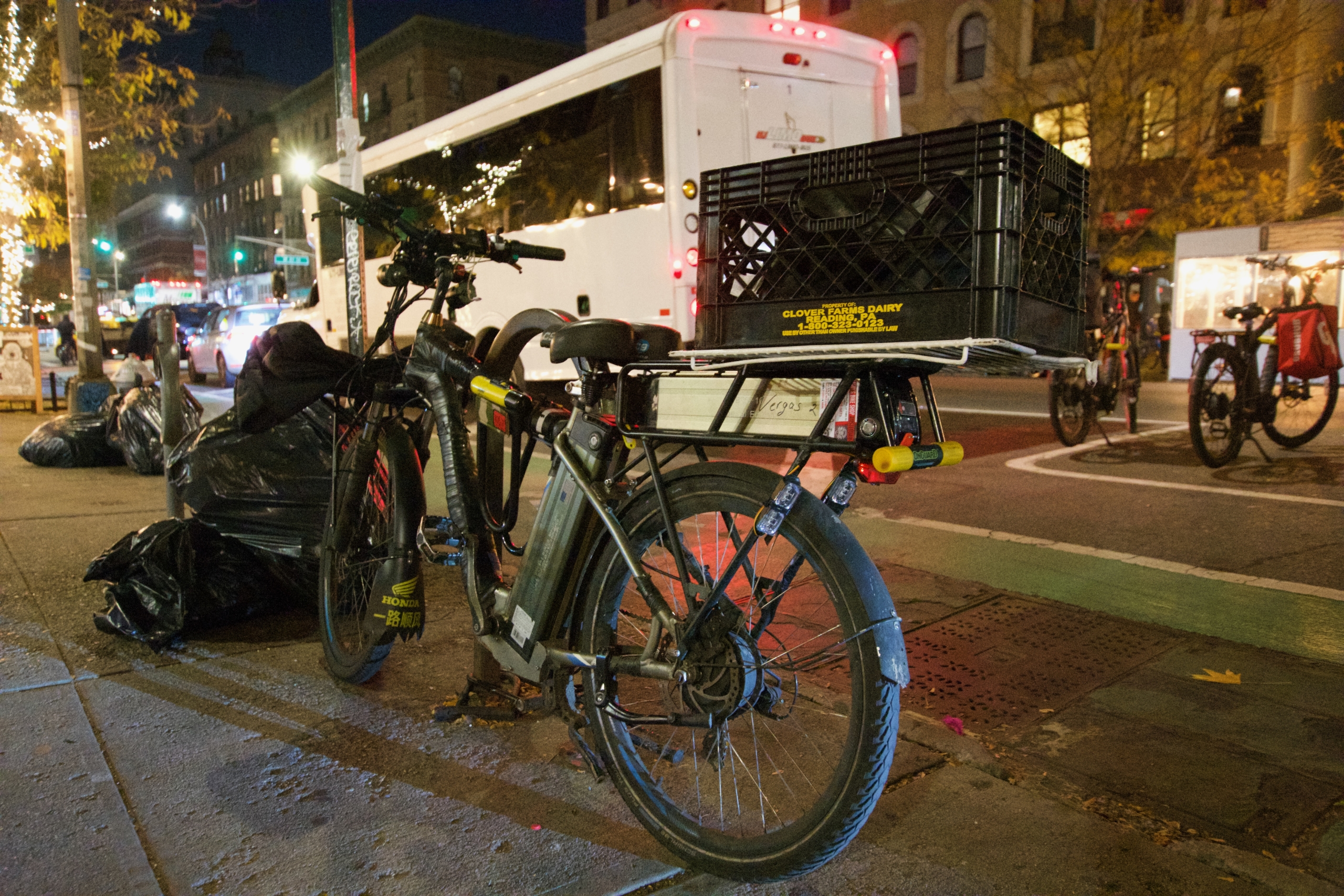
Armando said that four bikers tried to steal his bike one day on Riverside Drive. He said that after he begged them to let him go, “they left it and finally went away, but they also told me they were going to shoot me there,” he said. “It’s dangerous; they are waiting for people to arrive to take their things and rob them.”
Sticking together, either at a former dining shed or in small groups scattered around the city, helps them protect each other, especially at night, the deliveristas said. “That’s why we are in a group because, with any problem, everyone is already there,” said Armando. As temperatures fall, though, dining sheds and CitiBike stations offer little protection from winter winds.
For those who, like Armando, worked for a restaurant, being an employee not only meant a reliable source of income at the end of the month, but also a place to shelter between orders and an accessible bathroom. Still, some say they prefer the independence of working for apps. “In a restaurant you have to be liked by the employer to feel comfortable in the place,” said Armando. “Here on the street you are at ease.”
For a workforce that’s overwhelmingly composed of immigrants and people of color, dealing with racism is part of their daily routine. “Sometimes people get run over on bicycles because the police don’t care. It’s not like a white guy,” said Armando. “I try to drive the best I can, but there are cars that don’t respect you,” said Verónica, a 22-year-old from Guatemala City, who has been working as a deliverista for the past three months, in an interview in Spanish. “I think it’s racism.”
Veronica, who is undocumented, came to New York City six years ago. She worked as a cook, a cashier and in a garment factory before hitting the road as a deliverista, a job she chose because it gave her more time to take care of her four-year-old daughter. Veronica said she gets up around 6:30 each morning at the Sunset Park house she shares with her husband and gets to the Upper West Side’s Oaxaca Taquería around 9:30, usually making about 15 deliveries until she stops at 4:30 to take care of her daughter..
In other jobs, “they will not give you the schedule you want, but the one they want,” said Veronica. “That’s why I’m now in delivery.”
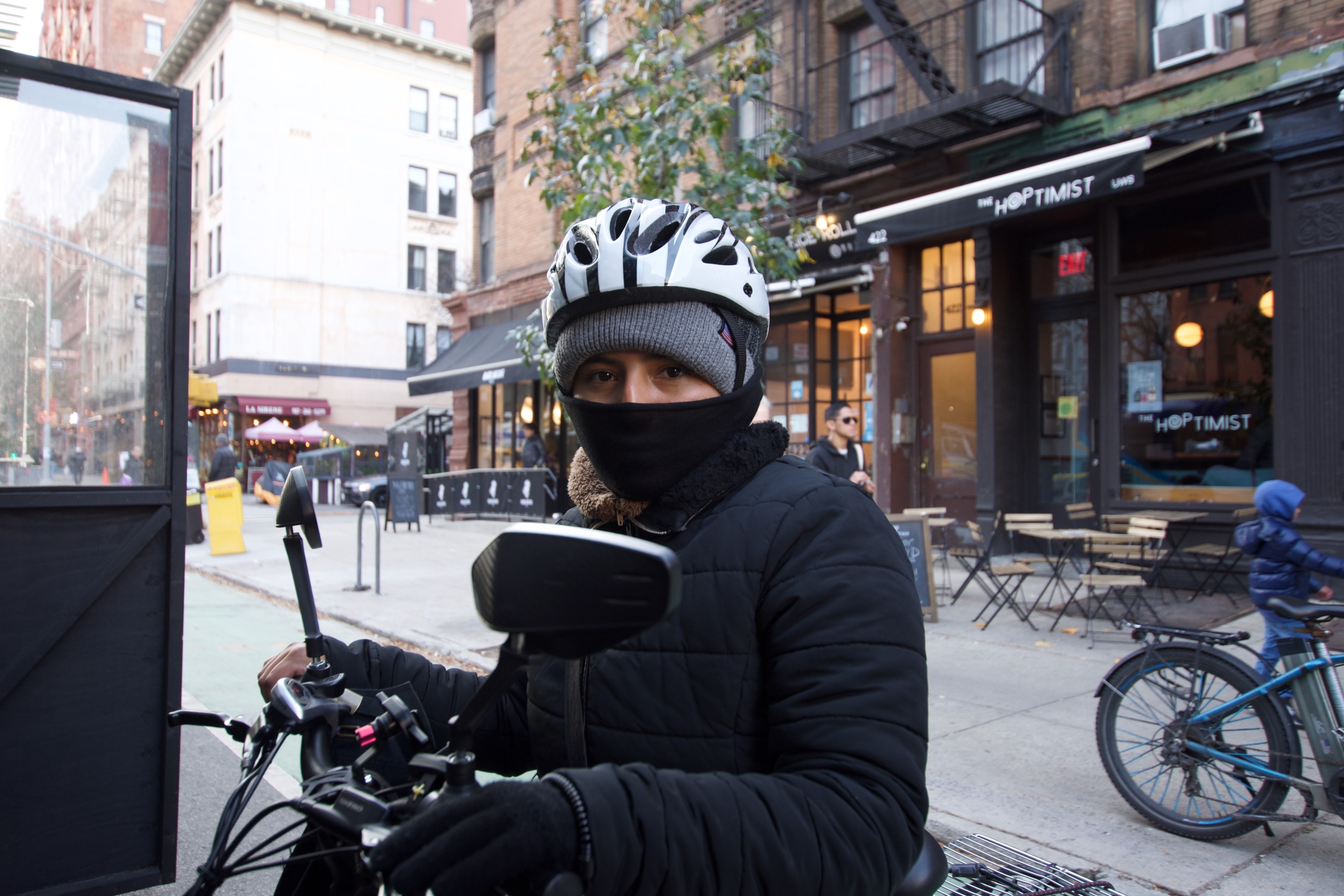
Although each deliverista has a different backstory, most share a single dream: working until they earn enough to return home, to Hidalgo, or Puebla, or Guatemala City, or wherever their loved ones are. “There’s nothing like home,” said Alberto. “The idea is to achieve your dreams and return with your family to live in peace.”









Thank you for this thoughtful coverage!
I second this emotion! These folks deserve recognition, fair compensation and respect. And anyone who doesn’t tip (or less than 15-20% honestly) shouldn’t be ordering delivery.
This is probably the best article I’ve read from you guys. Thank you for illuminating the workers’ stories!
Thank you so much for educating us about these people we see going by every day. A story like this belongs in The NY Times. I have heard someone say, “What are we going to do with all these people?” But when I see what they are doing – not only the delivery people – but the construction workers, the nannies, the supermarket workers, the store clerks, etc., my question is, “What are we going to do WITHOUT these people?”
Without immigrants, particularly illegal immigrants, wages will rise, income inequality will decline, and many poor Americans will have higher incomes.
This is demonstrably false both in the US and also in the UK which is now reaping the bitter seeds of Brexit.
Rather than point you at the many articles that review the data, a very recent example is:
“Construction is one of the biggest employers of undocumented immigrants, with 1.4 million workers across the country filling more than 1 in 10 jobs, researchers say. Nationwide, undocumented immigrants account for 23 percent of construction laborers, 38 percent of drywallers and 32 percent of roofers, according to a report by the nonprofit Center for American Progress last year.
Texas, where Gov. Greg Abbott (R) is paying to bus recent border crossers to predominantly Democratic states and the District of Columbia, has the highest number, some 311,000 construction workers, according to the most recent available data from the nonpartisan Migration Policy Institute. Florida had more than 100,000 undocumented construction workers before Ian hit.
Undocumented immigrants also dominate a nomadic new workforce that is chasing violent storms fueled by climate change, accounting for the vast majority of the day laborers who cleaned up after Hurricane Harvey in 2017 and Hurricane Ida last year, according to the National Day Laborer Organizing Network.
‘What has emerged is a transient workforce like farmworkers of yesteryear,’ said Saket Soni, executive director of Resilience Force, a nonprofit that has helped hundreds of undocumented workers on the ground since Ian. ‘They follow storm after storm, city after city.’
Around Southwest Florida, drivers in pickup trucks and big white vans arrive before dawn to collect workers from sidewalks and parking lots. They offer work demolishing storm-damaged buildings on wealthy Sanibel Island and tarping roofs in Fort Myers. Other laborers are hired to rip up soggy floors in places like Bonita Springs. Some pay $7 an hour. Others $200 a day.” (WaPo: “Florida needs workers to rebuild after Ian. Undocumented migrants are stepping in” 10/23/2022)
Mike, I am not in favor of illegal immigrants. We do not have enough room for everyone who wants to come in. We are a country of laws and need to control our borders. But still, my experience is that many, if not most, jobs that these people take are not attractive to American citizens.
I wonder how YOU would feel if YOUR family – since ALL of us were immigrants at one time or another – were told that “we do not have enough room for you…we are a country of laws and need to control our borders.” So it’s okay for you and your family, but not for others?
All I can say is…Wow!
What makes you say that? When I was an undergrad at Yale, I and several of my friends, all US citizens worked as garbage men to make ends meet.
Sure most will not, but some will.
Thank you for this thoughtful coverage which highlights the hard working people who are so close by, and yet, sometimes, are not clearly in focus.
It’s excellent to hear their voices. I hope they achieve their dreams…and stay safe.
i think this encapsulates my sentiment perfectly. “so close by, yet sometimes not clearly in focus”. such an important piece. thank you WSR!
Seriously, thank you West Side Rag! I have seen these guys (and gals) zipping through the streets and really wondered about them and worry for their safety. I know New York has always had delivery, but I feel like it just exploded during lockdown. I am happy to hear the neighborhood has a good reputation. I also did not know about the hourly wage, please consider follow up coverage about that once it starts
A sensitive and meticulously detailed analysis of the pressing issues faced by los deliveristas. Thank you, Alex Maroño Porto, for the caring and effort that you put into this report
Thank you for this fine story. Was glad to learn about their jobs.They work so hard. Hope they get minimum wage boost. Would be nice if they could get benefits as well —
Excellent, informative piece. Refusing deliveristas bathroom access is an abomination.
Great story — one of your best. Much appreciated.
Well, I don’t suppose there is any all-encompassing answer to all the myriad issues raised here by Alex Maroño Porto’s article, but let me, anyway, suggest one: UNION. A bit old-fashioned in our Reaganite reality, but it still really works.
” 16 New York City deliveristas were killed in 2020 and 2021, the majority of them in traffic accidents. ”
There are no accidents. There are only collisions. The term ‘accidents’ implies that they were unfortunate but unavoidable. They are, in almost all cases, avoidable. The incidents quoted where a cyclist was both doored and struck by a car going through a red light were not caused by unfortunate ‘accidents’, the cyclist was a victim of automobile drivers exhibiting illegal and dangerous behavior on our streets (common behavior, as any cyclist or pedestrian can attest to) .
Getting struck by a meteorite is an accident. Getting struck by an automobile is not.
What do you call pedestrians getting hit by deliveristas who ride on the sidewalks, or collisions on the road caused by deliveristas or other cyclists who don’t obey traffic rules? Is that also illegal and dangerous behavior? At least cars are required to have insurance and license plates. Not that always helps especially with hit and runs, but cyclists cause a lot of collisions as well.
I call them collisions. Not accidents.
How can an undocumented person work for Doordash/Grubhub?
Interesting article. It sounds like a path to citizenship isn’t necessarily the objective for at least some of these folks, just fair wages and access to benefits like others working and living in the US. Instead of this all or nothing approach of solving illegal immigration situation which stalls things every time legislation come forward,, why don’t the employers pursue legal channels like migrant worker Visas or another class for this kind of employment? This way everything would be above board , taxes would be collected, and access to services could more easily be obtained.? If there is work that needs to be done and these men and women are willing to do it, why make it harder than needs to be? I’m also all for paying minimum wage and salary but I assume that means taxes would be collected? Also, the delivery company and restaurant won’t be absorbing this extra cost. How much is it worth it to you for the convenience of getting your burrito delivered pronto?
Thank you for sharing these stories. Something needs to be done to make their lives and the lives of pedestrians safer! There are no excuses for these deliveristas to drive recklessly. Endangering their lives and the lives of innocent pedestrians. Maybe we can wait another minute or 2 for a restaurant delivery and be a safer community all around.
As long as they’re classified as independent contractors and doing piece work this won’t change.
Classify these workers as employees and put the onus for safety on the multi millionaires who employ them and you’ll see changes. Especially now that their defective batteries are causing so many fires.
Or the NYPD could simply arrest a few of them for obviously and dangerously running red lights, something they do thousands of times a day, and you’d see a marked improvement in their driving.
But you’re right, the businesses large and small employing them need to be held liable.
How about some ‘thoughtful coverage’ of the lives and dreams of the people who almost get hit by ‘deliveristas’ riding illegally on the sidewalk, and through red lights?
What is it here with the mentality here of people who value the lives and hopes, dreams, and aspirations of illegal immigrants behaving illegally and dangerously, and imperiling the lives of others?
Do you think they do that because they’re heartless monsters who really enjoy running down little old ladies, or because they are working at poorly-paid, precarious jobs where they’re under constant time pressure? If you want to be mad at someone, look to the delivery companies themselves…and to yourself, if you lose your stuff at the idea of waiting an extra [x] minutes for your delivery.
You can feel compassion for people experiencing difficult situations, understand their desperation AND expect them to still follow the law. Those delivery workers who are undocumented are breaking the law by working. They entered this country knowing they were breaking the law. Those hiring them are breaking the law. People have choices.
Adding my appreciation for this excellent article. Thank you!
A terrific well-reported, well-written story that pulls the curtain back on part of our “shadow economy”. Congrats on a great public service!
Ask the folks over 60 and the disabled what they think of the sidewalk riding, light ignoring delivery drivers. There is no mention of the large number of this group who have been killed or injured by the bikers. Have we forgotten how to get our slice of pizza, etc, ourselves? And what if it takes a few minutes more to satisfy our “dire” need.
Your article describes the difficult work life of delivery people, many of whom use electric bikes and scooters. Much as we sympathize with these workers and deplore their working conditions, shouldn’t mention have been made of the numerous accidents they are responsible for in their need to work as speedily as possible? Why was nothing said in your article about informing these workers, as well as those on ordinary bikes, about traffic regulations and laws regarding them? Going through red lights, riding the wrong way on one-way streets and zigzagging on sidewalks are all causes of serious accidents. And yet, there seems to be no way for the city to enforce the law and protect pedestrians. Improve the lot of delivery workers, yes, but next time, give us a more balanced picture.
While I full support the premise of this article, I want to know when we are going to hold these workers to account for the danger they create on the road. Most of them do not obey traffic laws, and are a terror to pedestrians, particularly the elderly, who cannot move out of the way quickly enough. Why do we keep rewarding these workers without creating some kind of requirement that they ride safely – for others and themselves? What happened to easily identifiable vests, with easily read telephone numbers, so that people can call if they see reckless riding, or are the victim of it (even if they are not injured)? What happened to restaurant owners being fined if their workers do NOT obey the law? What happened to all the safeguards that were discussed ad nauseam over the past two decades?!?!?!
I agree wholeheartedly. The mere fact that they are undocumented and working illegally makes it harder for them to be held accountable for harm caused to others, even if accidental. Unless they stay at the scene of the collision, lots of luck catching them or having any recourse for taking responsibility. If a police office asks them for ID what will they show? Is this what it means to be a sanctuary city? And $50 to see a doctor? Look what other people pay when they have insurance.